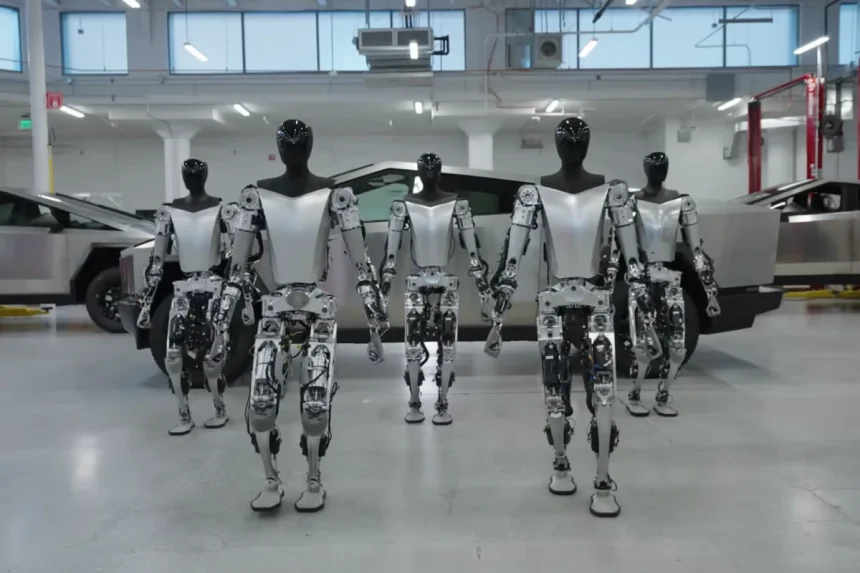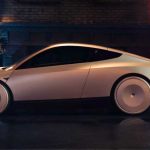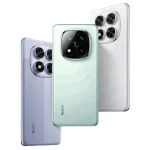The Tesla Optimus Bot is causing a revolution in the world of robotics and artificial intelligence. This groundbreaking humanoid robot, unveiled by Elon Musk’s Tesla, represents a significant leap forward in automation technology. With its advanced capabilities and potential to transform various industries, the Optimus Bot has sparked intense interest among tech enthusiasts, businesses, and the general public alike. Its development signals a new era in which robots may become an integral part of our daily lives, performing tasks ranging from household chores to complex industrial operations.
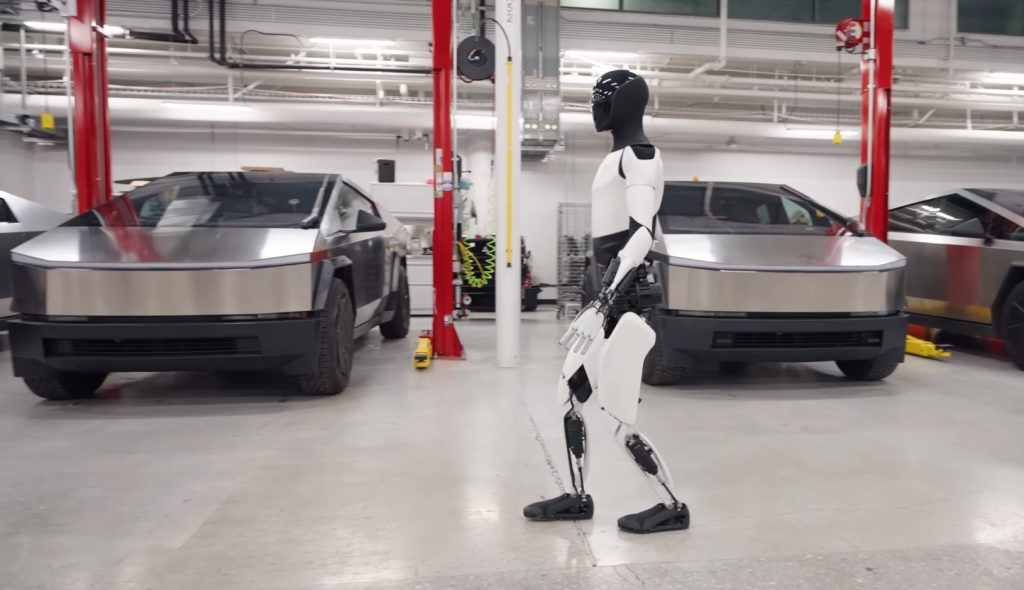
What sets the Tesla Optimus Bot apart from other humanoid robots is its combination of cutting-edge AI, machine learning algorithms, and sophisticated hardware. This article will explore the origins of the Optimus project, delve into its key features and real-world applications, and examine the technology that powers this remarkable machine. We’ll also compare Optimus to its competitors, discuss its potential impact on society, and consider the future prospects for this $20,000 robot. By the end, readers will have a clear understanding of how the Tesla Optimus Bot is shaping the future of robotics and AI.
The Genesis of Tesla’s Optimus Bot
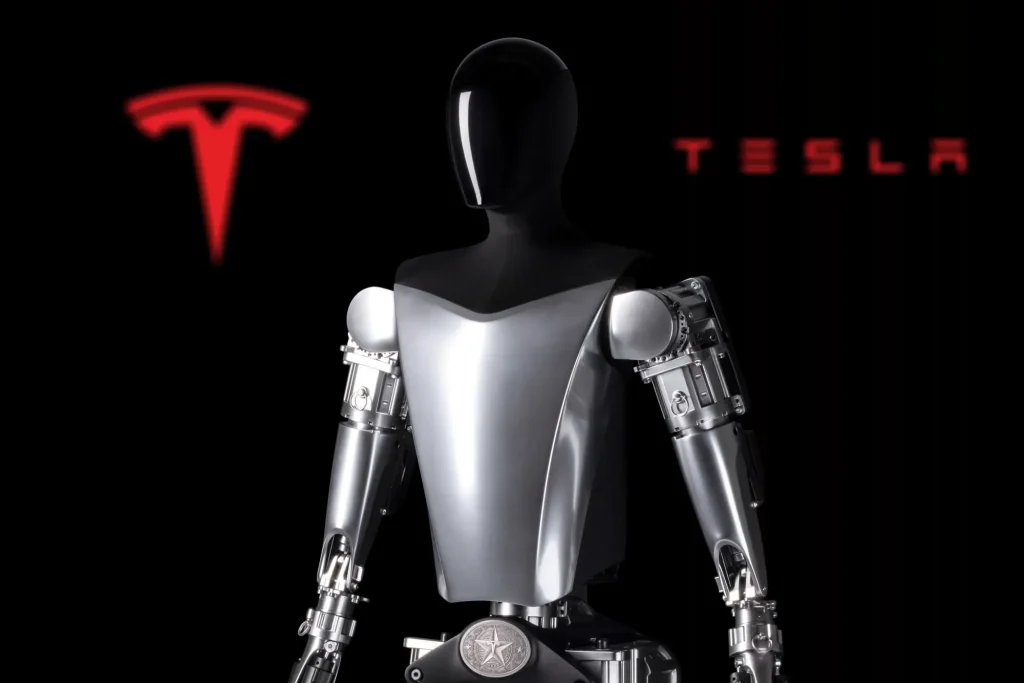
Initial concept and unveiling
The journey of the Tesla Optimus Bot began with a groundbreaking announcement during Tesla’s AI Day in 2021. Elon Musk introduced the concept of a versatile humanoid robot designed to handle tasks that are unsafe, repetitive, or monotonous for humans. This initial unveiling sparked intense interest and speculation about the future of robotics and artificial intelligence.
The initial presentation featured a person in a bodysuit, representing the proposed robot’s appearance and capabilities. While this theatrical approach raised some eyebrows, it effectively conveyed Tesla’s vision for a multi-functional machine that could revolutionize various industries.
Evolution from prototype to Gen 2
Following the initial announcement, Tesla made rapid progress in developing the Optimus Bot. In 2022, the company revealed a functional prototype that could walk and perform basic actions. During a live demonstration, Elon Musk highlighted that it was the robot’s first untethered operation, showcasing its ability to move independently. Videos displayed the bot successfully picking up objects and watering plants, demonstrating its potential for practical applications.
The prototype’s capabilities were impressive, considering the short development time. It could walk, lift objects, and interact with its environment in rudimentary ways. However, this was just the beginning of Optimus’ evolution.
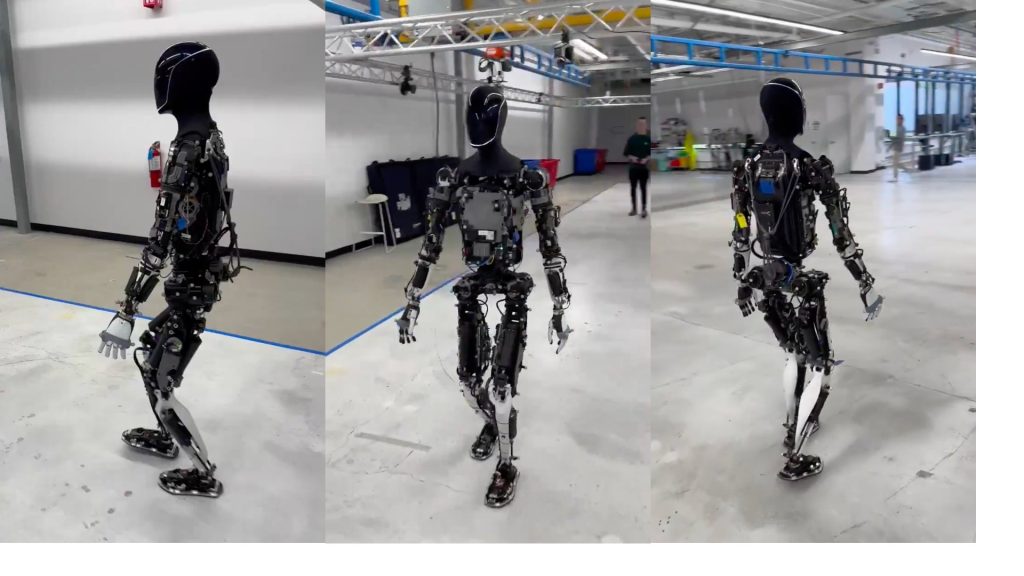
In December 2023, Tesla introduced the Optimus Gen 2, marking a significant leap forward in the robot’s development. This latest iteration boasts several improvements over its predecessor, including:
- Faster walking speed
- Enhanced hand movements
- Tactile sensors on its fingers
- Improved overall functionality
The Optimus Gen 2 represents a substantial advancement in humanoid robotics. Its enhanced capabilities bring it closer to Tesla’s vision of a versatile machine capable of performing a wide range of tasks in various settings.
As the development of the Tesla Optimus Bot continues, it has the potential to transform multiple industries. From manufacturing and logistics to healthcare and personal assistance, the applications for this advanced humanoid robot are vast. The evolution from concept to functional prototype and now to the Gen 2 model demonstrates Tesla’s commitment to pushing the boundaries of robotics and artificial intelligence.
The rapid progress made in just a few years suggests that the future of humanoid robots may be closer than many initially thought. As Tesla continues to refine and improve the Optimus Bot, it has the potential to become a significant player in the robotics industry, potentially rivaling the company’s success in the automotive sector.
Key Features and Capabilities
The Tesla Optimus Bot has a range of impressive features that set it apart in the field of humanoid robotics. Its design and capabilities reflect Tesla’s commitment to creating a versatile and efficient machine that can seamlessly integrate into various environments.
Physical specifications
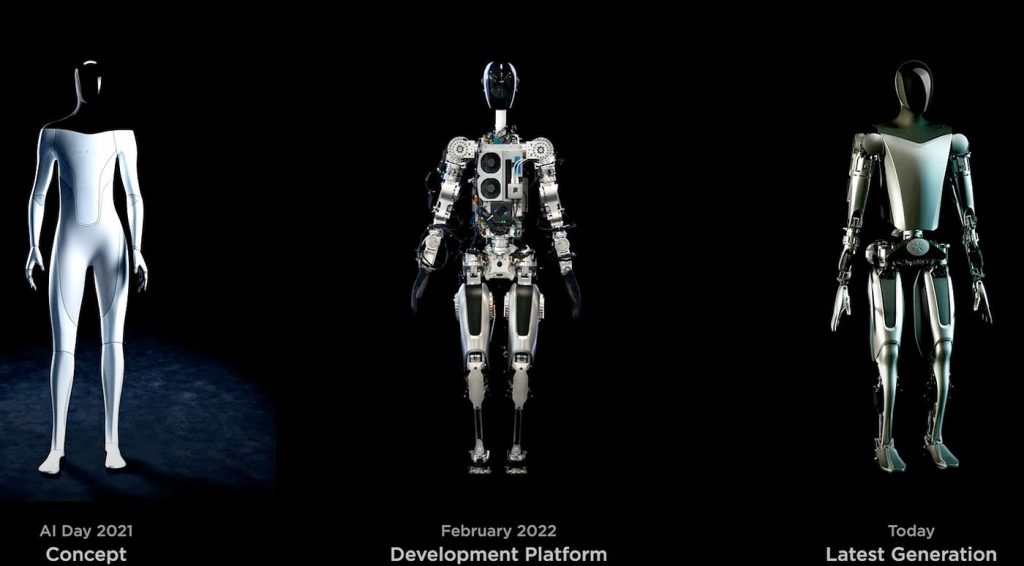
The Optimus Bot stands at approximately 5 feet 8 inches (173 cm) tall and weighs between 125 to 160 pounds (57 to 73 kg). This human-like size and weight allow it to navigate spaces designed for people easily. The robot’s body is constructed using a combination of metal and plastic, with an emphasis on lightweight materials to enhance efficiency and mobility.
One of the most remarkable aspects of the Optimus Bot is its dexterity. It boasts 28 structural actuators that grant it impressive flexibility and human-like movement. The robot’s hands alone have between 11 to 22 degrees of freedom, enabling it to handle delicate objects and perform complex tasks with precision.
The Optimus Bot has a carrying capacity of 45 pounds (20 kg) and can deadlift up to 150 pounds (68 kg). These capabilities make it suitable for various tasks, from household chores to industrial applications. The robot can move at a speed of up to 5 miles per hour (8 km/h), allowing it to keep pace with human walking speed.
AI and machine learning integration
At the heart of the Optimus Bot’s capabilities is its advanced artificial intelligence system. The robot is equipped with Tesla’s neural network and AI systems, allowing it to adapt to its environment, learn new tasks, and carry out operations autonomously. This AI integration enables the Optimus Bot to perceive and navigate its surroundings without human input.

The robot features eight autopilot cameras, similar to those used in Tesla’s Full Self-Driving (FSD) vehicles. These cameras, combined with other sensors, provide the Optimus Bot with a comprehensive understanding of its environment. The robot’s “brain” consists of a central computer powered by an AI chip containing a trained neural network.
Task versatility
The Optimus Bot has been designed to perform a wide range of tasks, making it a highly versatile machine. It can handle everything from carrying groceries and walking pets to more complex operations like babysitting or acting as a personal assistant. In industrial settings, the robot has the potential to revolutionize labor-intensive sectors by taking on repetitive tasks in manufacturing, handling heavy materials, or navigating complex industrial environments.
The robot’s ability to learn tasks by observing humans or through remote operation further enhances its adaptability. This feature allows the Optimus Bot to be quickly trained for new tasks or to adjust its performance based on specific requirements.
In logistics, the Optimus Bot could optimize warehouse operations, potentially reducing human error and increasing efficiency. Its versatility extends to service industries as well, where it could take on roles ranging from bartending to hotel management – tasks that require physical interaction but not necessarily human judgment.
Optimus in Action: Real-World Applications
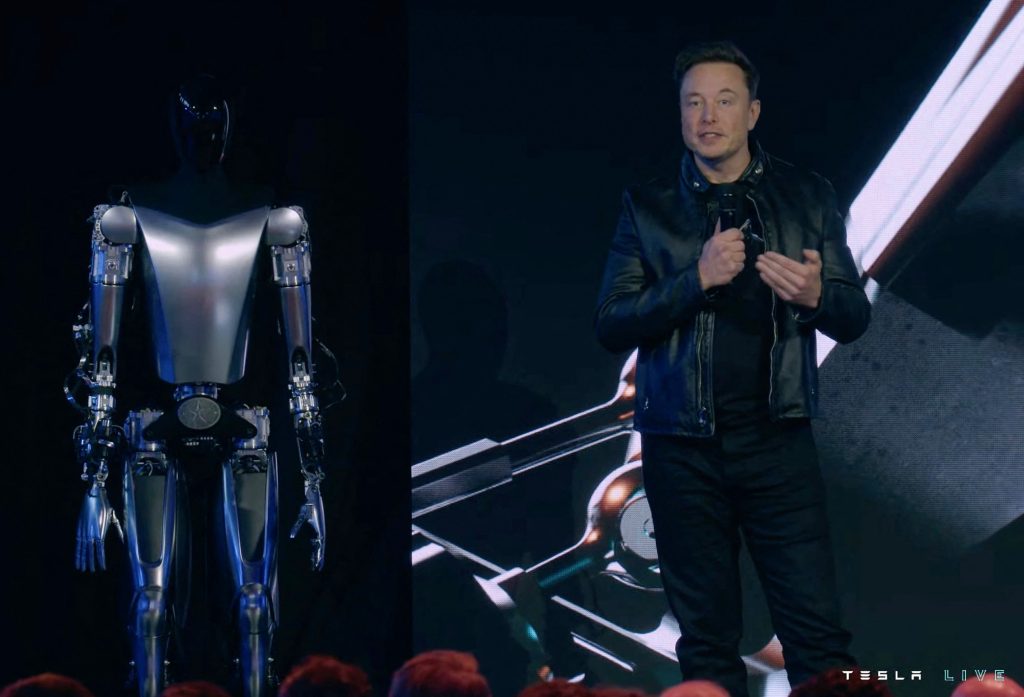
Industrial and manufacturing use cases
The Tesla Optimus Bot has the potential to cause a revolution in labor-intensive sectors, particularly in manufacturing and industrial environments. Elon Musk has emphasized that the robot could replace humans in high-risk jobs, such as repetitive tasks in manufacturing, handling heavy materials, or navigating complex industrial environments. Tesla itself has already begun to test Optimus in its factories, where the robot moves parts and assists in assembly lines.
Researchers have examined the application of the Tesla bot in manufacturing environments, developing frameworks to define tasks suitable for robot involvement. These tasks are based on the physical characteristics of parts and components, such as shape, material features, and variability. The robot’s capabilities, including its two arms, mobility, collaboration ability with humans, and safety features, make it well-suited for various automation arm-based tasks.
Studies have shown that the use of the Tesla Optimus bot can reduce up to 75% of manual assembly time. However, due to task interdependence, only about 60% of total tasks were automated in one study. Additionally, material handling tasks, which account for 60 minutes in a shift, were also automated.
Household assistance and daily tasks
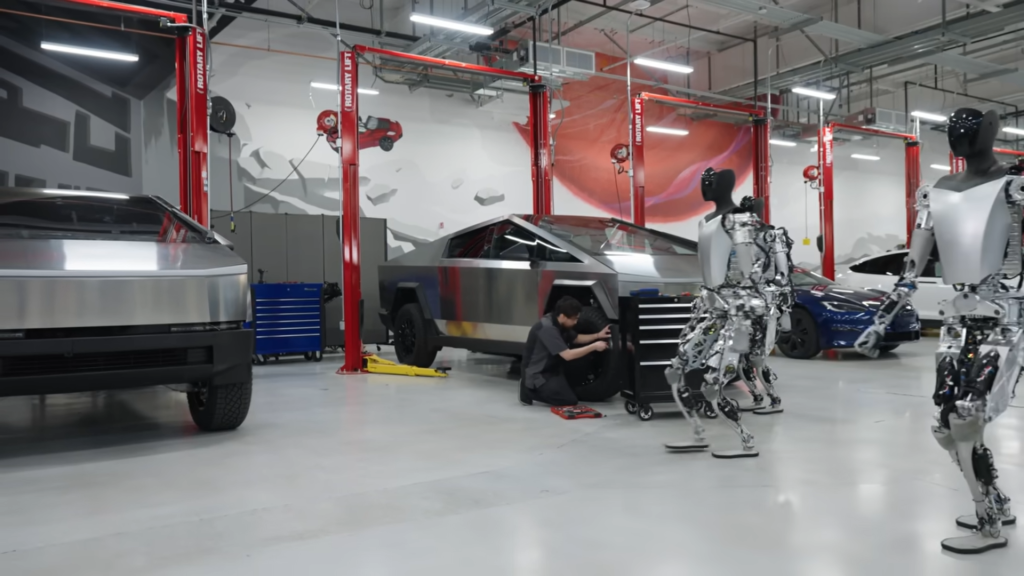
One of the main applications of the Tesla Optimus Bot is to integrate it into households to perform specific tasks. The robot will build a complete understanding of its environment, enhanced by shared 3D scans of the home and its perception capabilities. Moreover, the bot will be accustomed to the profiles of household members, recognizing their habits, hobbies, and preferences, and fostering personalized interactions.
Imagine a future where a robot like Optimus helps with morning chores, folds laundry, and serves coffee—all while adjusting to specific preferences. The bot’s ability to learn tasks by observing humans or through remote operation further enhances its adaptability. This feature allows the Optimus Bot to be quickly trained for new tasks or to adjust its performance based on specific requirements.
Potential for eldercare and healthcare
In the healthcare sector, AI robots like the Tesla Optimus Bot can revolutionize patient care. They can assist in hospitals and elderly care facilities, performing tasks ranging from delivering medications to monitoring patient vital signs. This assistance can reduce the workload on healthcare professionals, allowing them to focus more on direct patient care and critical tasks.
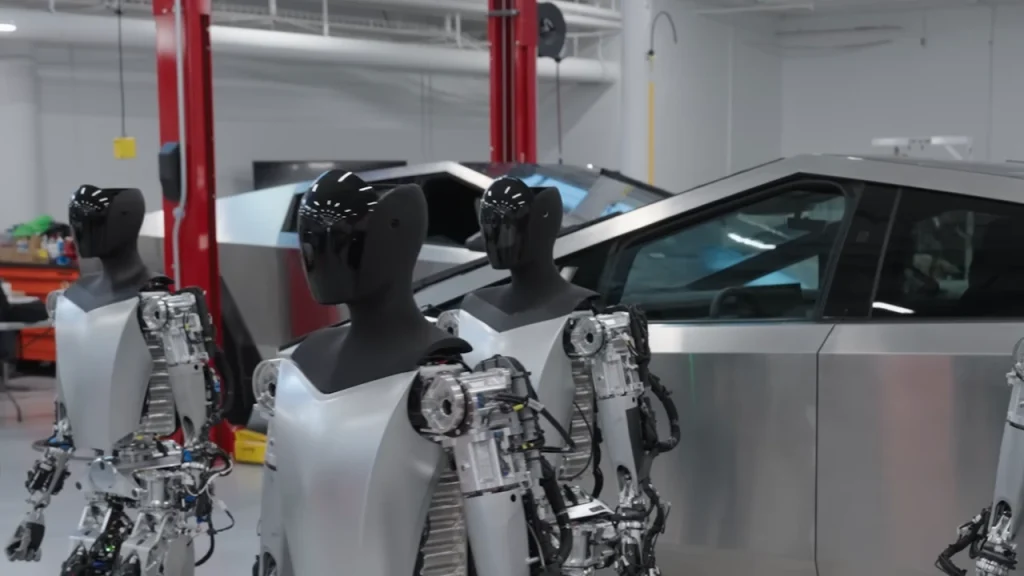
The Optimus Bot has the potential to play a crucial role in eldercare. It can help seniors stick to their medication schedules by giving reminders, keep track of medical appointments, and even alert family members if there are signs of unusual behavior. Thanks to its sensors, the bot can easily monitor basic health metrics like blood pressure, heart rate, and blood sugar levels, reporting any issues to doctors or family members as needed.
With these features, Optimus isn’t just a piece of technology; it’s a dedicated caregiver that enhances safety and improves the quality of life for the elderly. Integrating care robots like Optimus is a significant step forward, not only helping to reduce the workload of healthcare workers but also ensuring that each elderly person receives attentive care 24/7.
The Technology Behind Optimus
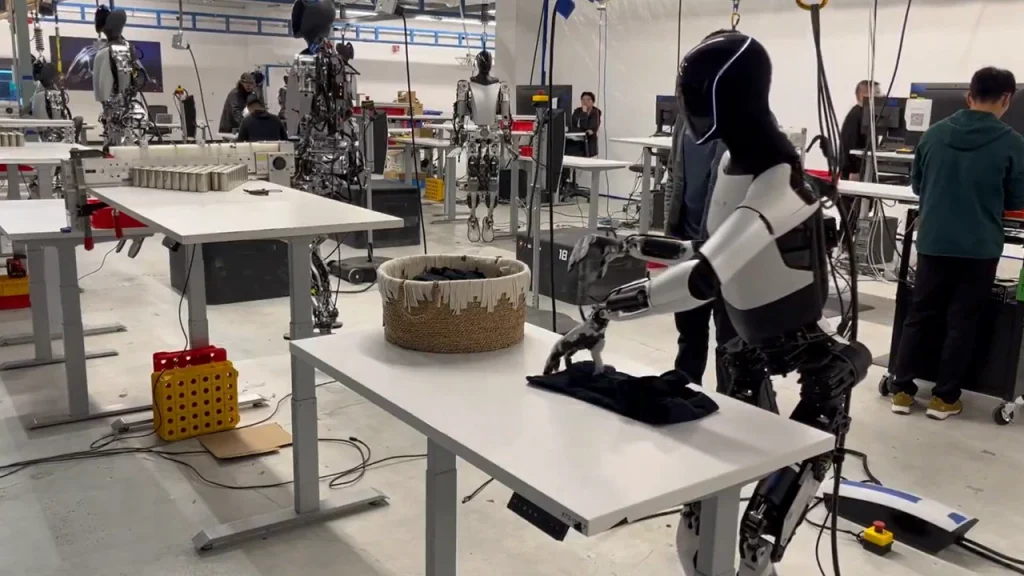
Tesla’s AI and robotics expertise
The Tesla Optimus Bot represents a fusion of cutting-edge robotics and artificial intelligence, drawing upon Tesla’s extensive experience in developing AI systems for its electric vehicles. This deep integration of AI technologies is what sets the Tesla Bot apart, enabling it to perform a wide range of tasks with a level of autonomy and precision that mirrors, and in some cases extends, human capabilities.
At the core of the Optimus Bot’s functionality is an advanced AI system that harnesses the power and insights gained from Tesla’s autopilot and AI technologies. This system is designed to interpret complex environments, recognize objects and obstacles, and adapt its actions accordingly, much like how Tesla’s vehicles analyze and respond to their surroundings.
The utilization of autopilot technologies in the Tesla Bot is a testament to Tesla’s innovative approach to AI. These technologies, honed through millions of miles of real-world driving data, provide the bot with an unparalleled ability to perceive its environment. This includes advanced object detection, spatial awareness, and decision-making capabilities underpinned by deep learning algorithms.
Hardware innovations
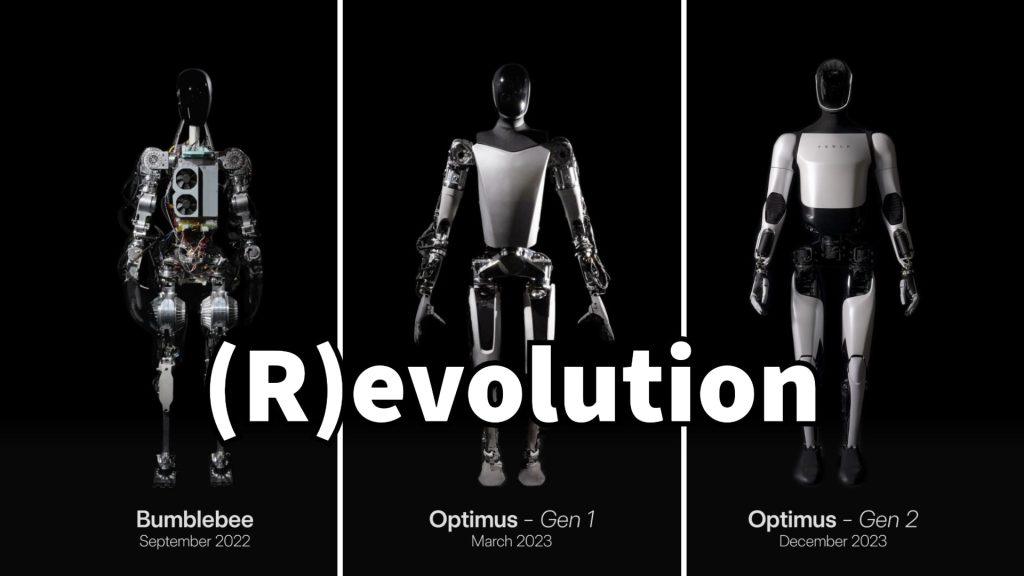
The physical design of the Tesla Optimus Bot enhances its AI-driven capabilities. Standing at approximately 5 feet 8 inches (173 cm) tall and weighing between 125 to 160 pounds (57 to 73 kg), the robot is designed to navigate spaces built for humans easily. The bot is equipped with human-like hands, allowing it to grasp and manipulate objects with precision. This versatility is crucial for a robot designed to assist in both domestic and professional environments.
The Optimus Bot boasts 28 structural actuators that grant it impressive flexibility and human-like movement. The robot’s hands alone have between 11 to 22 degrees of freedom, enabling it to handle delicate objects and perform complex tasks with precision. These actuators translate the information received from sensors into physical movement, allowing the bot to perform a wide range of tasks.
Software and control systems
The software powering the Tesla Optimus Bot is a marvel of engineering, integrating advanced AI and machine learning algorithms. The bot’s “brain” consists of a central computer powered by an AI chip containing a trained neural network. This system allows the bot to adapt to its environment, learn new tasks, and carry out operations autonomously.
The Optimus Bot features eight autopilot cameras, similar to those used in Tesla’s Full Self-Driving (FSD) vehicles. These cameras, combined with other sensors, provide the bot with a comprehensive understanding of its surroundings. This perception system allows the bot to navigate through various environments, whether it’s maneuvering around a home, office, or industrial setting, with a level of finesse and understanding that mimics human navigation.
Optimus vs. Competitors: A Comparative Analysis
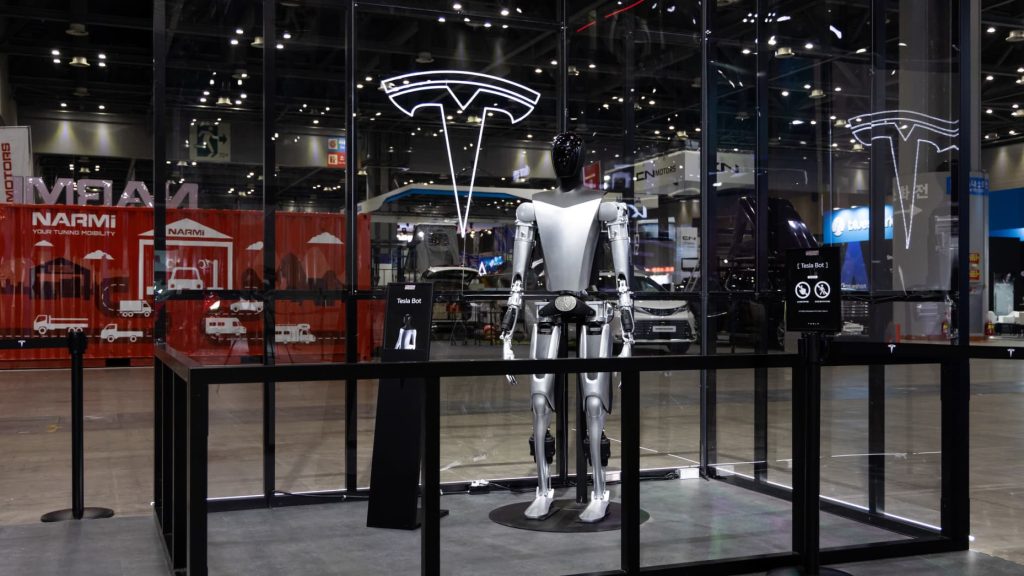
How Optimus stacks up against other humanoid robots
The Tesla Optimus Bot has made significant strides in the field of humanoid robotics, but it faces stiff competition from established players and emerging startups. When compared to other humanoid robots like Boston Dynamics’ Atlas, which can perform parkour, the Optimus Gen 2 has shown impressive improvements over its predecessor. However, some experts find the prototypes to be less advanced in terms of movement capabilities.
One area where the Optimus Bot excels is in its rapid development cycle. Tesla’s robotics team has demonstrated a commendable ability to iterate quickly, designing the robot from the ground up with custom actuators and an integrated system. This approach has allowed Tesla to make significant progress in a relatively short time frame, potentially giving it an edge over competitors who have been in the field for decades.
The Optimus Bot’s hand design has also garnered attention. With a metallic cable-driven system featuring four fingers and a thumb, it has demonstrated a high loading capacity, capable of holding water cans and lifting aluminum bars in factory settings. However, this design may have limitations in terms of response time and autonomous manipulation compared to other robots.
Unique selling points and advantages
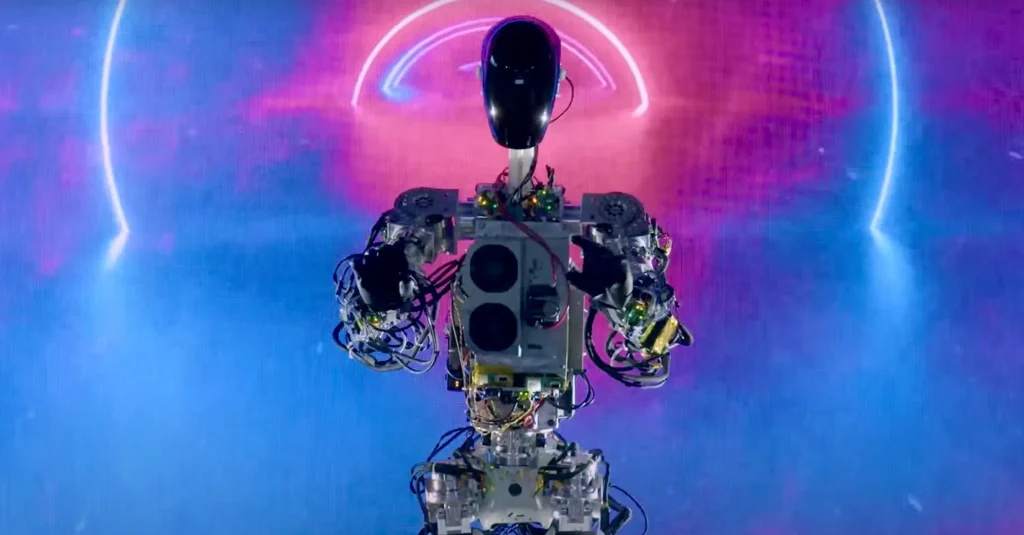
One of Tesla’s key advantages in the humanoid robot market is its expertise in artificial intelligence and full self-driving technology. The Optimus Bot essentially employs a full self-driving computer in robot form, leveraging Tesla’s vast AI team and refined machine learning algorithms. This integration of advanced AI systems sets Optimus apart from many competitors, potentially giving it an edge in autonomous decision-making and environmental adaptation.
Another significant advantage is Tesla’s manufacturing prowess. The company’s experience in mass-producing complex vehicles positions it well for scaling up production of humanoid robots. This capability could be crucial in making Optimus more accessible and affordable compared to competitors, with Elon Musk suggesting a potential price point of around $20,000 per unit.
The Optimus Bot also benefits from Tesla’s ambitious vision and marketing power. Elon Musk has boldly claimed that Optimus can “do anything” and has the potential to revolutionize the world. While these statements may be optimistic, they have undoubtedly generated significant interest and investment in the project.
However, it’s important to note that the humanoid robot market is still in its early stages, with many challenges to overcome. Competitors like Figure AI, founded in 2022, have also made impressive progress, demonstrating that innovation in this field is not limited to established players. As the market evolves, factors such as real-world performance, cost-effectiveness, and practical applications will ultimately determine the success of humanoid robots like Optimus.
The Future of Optimus and Its Impact on Society
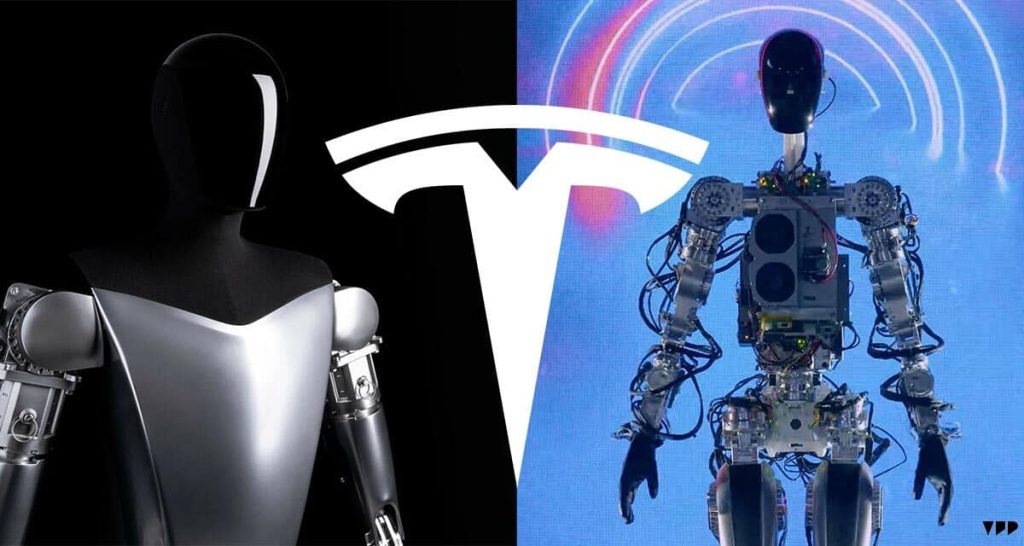
The Tesla Optimus Bot represents a significant leap forward in the field of humanoid robots and artificial intelligence. As the project continues to evolve, it has the potential to cause a revolution in various industries and aspects of daily life. However, the integration of such advanced technology into society also raises important ethical considerations and societal implications that must be carefully addressed.
Projected timeline for mass production
Elon Musk has outlined an ambitious timeline for the production and deployment of the Tesla Optimus Bot. According to recent announcements, Tesla aims to begin limited production of the Optimus robot for internal use by 2025. This initial phase will allow the company to refine the robot’s capabilities and test its performance in real-world settings within Tesla’s own facilities.
Following this internal testing phase, Musk envisions making the Optimus Bot available for sale to other companies by 2026. This timeline suggests that we may see humanoid robots becoming more prevalent in various industries within the next few years. However, it’s important to note that these projections are subject to change, as the development of such complex technology often faces unforeseen challenges.
The ultimate goal for Tesla is to achieve mass production of the Optimus Bot, potentially making it accessible to a wider range of businesses and even households. Musk has suggested that once mass production is achieved, the robot could be priced between $20,000 and $30,000, making it significantly more affordable than many current humanoid robots.
Ethical considerations and societal implications

The introduction of humanoid robots like the Tesla Optimus Bot into daily life and workspaces heralds a new era of human-robot interaction. However, this shift also raises important questions about the future of employment, the ethics of robot autonomy, and the societal impact of widespread automation.
One of the most pressing concerns is the potential for job displacement. As robots like Optimus become capable of performing a wide range of tasks, there is a risk that they could replace human workers in certain industries. This transition could be disruptive, necessitating policies and programs to retrain and redirect the workforce towards emerging roles that cannot be easily automated.
Privacy issues also come to the forefront with the integration of advanced robotics into everyday life. The Optimus Bot’s ability to perceive and navigate its environment raises questions about data collection and usage. Ensuring that these robots respect individual privacy rights will be crucial for their acceptance in society.
The ethical treatment of AI entities like the Tesla Optimus Bot introduces philosophical questions about the rights and responsibilities associated with advanced artificial intelligences. As these robots become more sophisticated, society may need to grapple with complex issues surrounding robot autonomy and decision-making capabilities.
Conclusion

The Tesla Optimus Bot marks a significant step forward in the field of robotics and AI. Its development showcases Tesla’s commitment to push the boundaries of technology, with potential applications ranging from industrial settings to households. The bot’s advanced AI, combined with its physical capabilities, opens up new possibilities to transform various sectors and improve daily life. As Tesla continues to refine and enhance the Optimus Bot, we can expect to see more groundbreaking advancements in the coming years.
While the future looks promising for the Optimus Bot, its widespread adoption will likely bring about significant changes in society. These changes may have an impact on the job market, raise ethical questions, and reshape how we interact with technology in our daily lives. As we move forward, it will be crucial to consider these implications carefully, ensuring that the integration of advanced robotics like the Optimus Bot benefits society as a whole while addressing potential challenges.
FAQs
- What functions can the Tesla Optimus robot perform? The Tesla Optimus robot is designed to walk forward, adjust its limbs, adopt various poses, and even balance on one leg. It is engineered to handle tasks that require bodily movement in multiple directions.
- What tasks is the Tesla bot designed to handle? The Tesla bot, known as Optimus, is a bipedal, autonomous humanoid robot intended to perform tasks that are either dangerous, repetitive, or mundane. Its development involves sophisticated software stacks that facilitate balance, navigation, perception, and interaction with the environment.
- What is the expected price range for the Optimus robot? The anticipated cost for the Optimus robot is projected to be between INR 1,675,314.08 and INR 2,512,971.13. Elon Musk has stated that he believes Optimus will be the most significant product ever created.
- What is Tesla’s approach to artificial intelligence? Tesla’s AI strategy primarily utilizes “computer vision,” which mimics human visual perception through cameras, combined with an end-to-end machine learning system. This technology converts visual data directly into actionable driving decisions.

